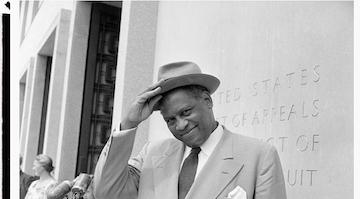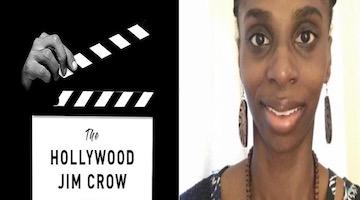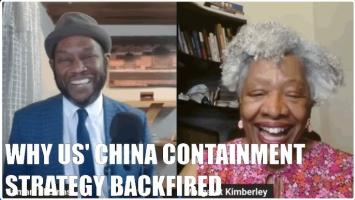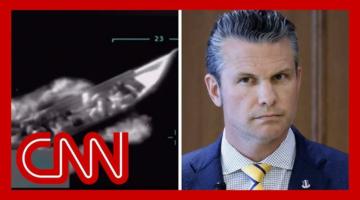Avoid anything that could be construed as progressive or risk never working in television again.
“To be an intellectual, like being black, was to be regarded as a potential subversive.”
The following is excerpted from MS. Stabile’s book, “The Broadcast 41: Women and the Anti-Communist Blacklist.”
Throughout much of the 20th century, critics and scholars dismissed television as a hopelessly lowbrow medium, inferior and common. But the FBI recognized that prime-time entertainment programming was a key battleground in the anti-communist war over American identity. The Bureau and other anti-communists were far less likely than progressives to make aesthetic distinctions between Hollywood and broadcasting, believing that Hollywood films and scripted radio and television programs alike exposed large audiences to dangerously radical social ideas and issues, by which they meant ideas not compatible with their preferred ways of seeing the world. These concerns caused the FBI to initiate investigations of communist influence in Hollywood before World War II, but the US’s wartime alliance with the Soviet Union stalled right-wing attempts to rid film of progressives. After the war ended, however, anti-communists renewed these efforts, initiating three new investigations into communists in Hollywood in September 1947, April 1951, and September 1951. The first of these investigations bore fruit when members of the group of filmmakers who came to be known as the Hollywood Ten were cited for contempt of Congress in 1947. “The long interval between the first and second investigations,” according to blacklisted writer Albert Maltz, resulted from the fact “that the legal case of the Hollywood Ten was proceeding through the Courts during that time.” That legal case concluded in June 1950, when three separate judges sentenced nine of the Ten to pay fines and serve time in prison.
“The Hollywood Ten were cited for contempt of Congress in 1947.”
Inspired by their victory over the Hollywood Ten, anti-communists turned their attention to television. The FBI considered broadcast programming threatening enough to require continuous surveillance and intervention. Indeed the Bureau helped produce programs favorable to the FBI’s point of view. Their most successful collaboration was with Phillips H. Lord on the popular reality series Gang Busters (1935–57), which used material drawn from the cold cases of the FBI. Not surprisingly, crime programs like Gang Busters and police procedurals were anti-communists’ preferred form of programming, since these genres affirmed their law and order perspectives and celebrated patriarchal moral values considered to be 100 percent American, a phrase anti-communists shared with the Ku Klux Klan.
In the late 1940s, a group of former FBI agents and military intelligence officers espousing these law-and-order perspectives led the charge against progressive influence in broadcasting. Financed by an unusual collaboration between Jewish anti-communist importer Alfred Kohlberg and the Catholic Church, these men established the American Business Consultants in 1946 (the definite article emphasizing their sense of self-importance). This organization published the influential anti-communist newsletter CounterAttack (1947–71) and their self-proclaimed bible of the blacklist, Red Channels: The Report of Communist Influence in Radio and Television (1950). The American Business Consultants also inspired imitators who helped spread the gospel of anti-communism, including AWARE, Inc., founded by the author of Red Channels’ Introduction, Vincent J. Hartnett, in collaboration with anticommunist supermarket-chain owner Laurence A. Johnson.
“Bureau helped produce programs favorable to the FBI’s point of view.”
The American Business Consultants propagated the idea that communists had infected broadcasting with their subversive virus, with the intent of spreading the disease of dissent to audiences. In his introduction to Red Channels, Harnett wrote, “The Communist-operated escalator system in show business has been in force for at least 12 years—since the Spanish Civil War. Those who are ‘right’ are ‘boosted’ from one job to another, from humble beginnings in Communist-dominated night clubs or small programs that have been ‘colonized,’ to more important programs and finally to stardom.” Anti-communists argued that the “so-called ‘intellectual’ classes—members of the arts, the sciences, and the professions” possessed dangerous, un-American ideas and that they must be prevented from access to the airwaves by any means necessary. As we will see, FBI files confirm journalist Betty Medsger’s observation that for the Bureau, “to be an intellectual, like being black, was to be regarded as a potential subversive, if not an active one.” Progressive intellectuals (including scientists, artists, and educators), in the estimation of anti-communists, were intent on nothing less than the “increasing domination of American broadcasting and television, preparatory to the day when—the Cominform believes—the Communist Party will assume control of this nation as the result of a final upheaval and civil war.”
“Anti-communists argued that the so-called ‘intellectual’ classes possessed dangerous, un-American ideas.”
With its cultural and intellectual elites, interracial social venues, and more liberal attitudes toward gender and sexualities, New York City loomed large in the anti-communist imagination as an incubator for subversive ideas, organized dissent, and, ultimately, revolution. The only way to stop this New York-based red menace, they argued, was to detect, expose, and prosecute communists and fellow-travelers working in broadcasting. To this end, the authors and publishers of Red Channels conducted research to “detect” threats, collaborating with the FBI, the HUAC, and other anti-communist researchers and organizations. They used publications like CounterAttack and Red Channels and a network of gossip columnists that stretched coast to coast to share information about progressives and give anti-communist organizations fodder for letter-writing campaigns and boycotts. Although anti-communists never won the legal victories they hoped for, they successfully tried and convicted those who dared to challenge them in a court of public opinion they had bullied into submission.
The publication date of Red Channels proved auspicious: the American Business Consultants self-published it on June 22, 1950, just three days before the start of the Korean War. The book’s cover featured a large, masculine red hand dramatically grasping a radio microphone, a metaphor for the impending seizure of radio and television by communists and their fellow-travelers. In Red Channel s’ Introduction, freelance anti-communist writer Vincent J. Hartnett followed J. Edgar Hoover in defining a fellow-traveler as a person who, while not technically a member of the Communist Party, “actively supports (travels with) the Party’s program for a period of time.” The expansiveness of this definition, and anti-communists’ liberal application of it, allowed the anti-communist movement to cast a capacious net in their hunt for communist influence.
“New York City loomed large in the anti-communist imagination as an incubator for subversive ideas, organized dissent, and, ultimately, revolution.”
Red Channels’ pages contained an alphabetized list of 151 names, each name accompanied by an inventory of Communist and Communist “front” organizations those listed were alleged to have supported. The slender volume served as a crucial weapon in anti-communists’ war on dissent. As early as 1950, social psychologist Marie Jahoda and New York Times journalist Jack Gould recognized that the primary function of the blacklist was, as Medsger later put it, to prevent “people from exercising their right to dissent.” In her study of “Anti-Communism and Employment Policies in Radio and Television,” Jahoda found that “ ‘blacklisting’ procedures are met with fear, frustration, a conviction that innocent people are suspected, constriction and cynicism on the part of talent; an unresolved conflict of conscience on the part of management, with a notion that going along with the temper of the times is required if they are to serve the best interests of their clients.” One employee Jahoda interviewed gave the following advice to those working in broadcasting: “Don’t do things that might show you in an unfavorable light. It’s not wise to get involved in politics.” Jahoda was herself an example of the price people paid for criticizing anti-communists: she left the US after she was blacklisted for her research on blacklisting.
“The primary function of the blacklist was to prevent people from exercising their right to dissent.”
The culture war anti-communists waged against those identified as subversive and politically impure reverberated across broad swaths of media, encompassing the liberal and literary left (poetry, novels, children’s literature, and non-fiction), news (print and broadcast), and mass-mediated popular culture (animation, film, radio, and comics). Conservatives attacked poetry in the 1950s, claiming that experiments with form (and thus challenges to tradition and convention) were a communist plot against American culture. Literary scholars have abundantly documented the impact of the Red Scare on African American literature, since anti-communists believed that cultural production on the part of black people could only be the work of outside (read: white) agitators. As literary critic William J. Maxwell put it, the FBI waged a “fifty-year crusade to bully and savor African American writing, always presumed to be a type of communist sophistry.” The anti-communist crusade, which eventually expanded to include all American popular culture, stifled creativity across media industries, including those from which television might have drawn for inspiration and innovation.
As a consequence of the blacklist, being involved—or having been at some point in the past been involved—in progressive politics could get you fired. Even though actual membership in the Communist Party was in steep decline during the 1950s, anti-communist estimates of the power and reach of the red network were increasing. For all their talk of greedy red hands reaching hungrily for the reins of control over media production, by the early 1950s, anti-communists controlled a far more powerful and influential anti-red network, one that combined the power of the FBI and other government branches and agencies with the reach of veterans’ organizations, private anti-communist organizations, television networks, advertisers, sponsors, and professional snitches. Hoover’s definition of a communist front—“an organization which the communists openly or secretly control”—equally applied to the FBI’s own relationships with the publishers of anti-communist newsletters and books like CounterAttack, Red Channels, AWARE, Inc., and Confidential Notebook, to take just a few examples. The authors of Red Channels may have had an acrimonious and paranoid relationship with their former employer, but they remained united with the Bureau in efforts to suppress challenges to their authoritarianism.
“By the early 1950s, anti-communists controlled a powerful and influential anti-red network.”
In an irony not lost on those smeared and vilified by the anti-communist web of paranoia and conspiracy, anti-communists like Hoover and Senator Joseph McCarthy lent urgency to their war on subversion by reference to the vastness of the communist propaganda machine, while at the very same time creating their own vast propaganda machine. The machine they made, in the words of media critics Edward Herman and Noam Chomsky, allowed them to “mobilize the populace against an enemy” so amorphous that it could be strategically deployed against anyone identified as a “Public Enemy” who threatened the values of the John Birch Society, the FBI, rising politicians like Richard M. Nixon, Ronald Reagan, and others who took up the torch of anti-communists’ political legacies. Equating struggles for civil rights and immigrants’ rights with the revolutionary overthrow of the U.S. government, anti-communists declared that challenges to their views resulted from the contaminating influence of the “Comugressive Party,” a portmanteau term frequently used in the pages of CounterAttack.
While the stated goal of anti-communists was to rid the airwaves of “parlor pinks” (a reference to East Coast intellectuals) and other subversives, the long-term effects of the blacklist proved as significant as the initial purge. The blacklist shaped the foundations of the new medium of television, sending a clear message to people working in the industry: avoid anything that could be construed as progressive or risk never working in television again. In this way, anti-communists controlled definitions of America and American values by creating climates hostile to progressive viewpoints in media industries. The elimination of subversives on the basis of presumed political sensibilities and the fear that followed from their removal allowed anti-communist ideas, as Chomsky and Herman observed, to function for decades as powerful mechanisms for imposing conformity.
“Anti-communists declared that challenges to their views resulted from the contaminating influence of the ‘Comugressive Party.’”
Some years later, writer Studs Terkel put his finger on the logic that attributed any criticism of anti-communism to the dire influence of communism. If, he asked an NBC executive, communists are against cancer, does that mean we have to be for it? The answer to Terkel’s question was a resounding yes. To extend this logic, if communists were for civil rights, then real Americans had to oppose them. If communists supported state-subsidized child care, then child care must be a communist plot. Thus did the blacklist set well-defined limits for the ideas that could be expressed in television without fear of “controversy” (a code word for subversive content), invoking these limits for years to come in order to govern the content of entertainment programming.
The Broadcast 41: Women and the Anti-Communist Blacklist by Carol A. Stabile is the story of how forty-one women—including Dorothy Parker, Gypsy Rose Lee, and Lena Horne—were forced out of American television and radio in the 1950s “Red Scare.”
Carol A. Stabile is Professor of Women's, Gender, and Sexuality Studies and Associate Dean for Strategic Initiatives for the College of Arts and Sciences at the University of Oregon. She is the author of Feminism and the Technological Fix, White Victims, Black Villains: Gender, Race, and Crime News in US Culture, and other books.
This article previously appeared in Portside.
COMMENTS?
Please join the conversation on Black Agenda Report's Facebook page at http://facebook.com/blackagendareport

Or, you can comment by emailing us at comments@blackagendareport.com














